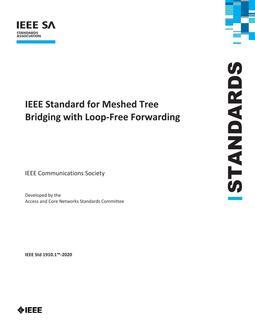More info
Full Description
Scope
The scope of this document is as follows:a) In bridged networks running MTBP, ports shall be identified as either a meshed tree port that participates in the meshed tree resolution, or a host port, to which a local host is connected. Only meshed tree ports are allowed to participate in the meshed tree resolution.b) MTBP provides superior fault tolerance by preconfiguring several logical trees from a root. One of these logical trees is considered the primary tree and is used for forwarding broadcast frames. In the event of a network component failure and immediately on failure detection of the primary branch, broadcast frame forwarding is taken over by any one of the other preconfigured tree branches. This is achieved with minimal message dissemination and delay.c) The addition of a bridge configured to run MTBP will allow the bridge to send a request to join (via MT_JOIN message) message to all other bridges to which it is connected. The new bridge will join the bridges already in the topology. The new bridge then receives multiple invitations from its neighbors to join tree branches that they are already part of. The new bridge decides to join the multiple tree branches and stores the multiple paths in order of preference. One of these paths shall be the path for broadcast frame forwarding.
Purpose
The purpose of this standard is to specify the methods for establishing several tree-like structures on an existing topology. The protocol leverages any useable path rather than eliminating possible alternate links. Upon changes to the topology, the meshed tree protocol will converge in zero time through the immediate use of alternate predetermined viable pathways on failure detection.MTBP allows for maintenance of multiple active topologies by adopting the MTA (described in Clause 5). The concept of meshed trees is novel in that they do not use the traditionally prevailing concept of a single tree from one root. They allow for multiple trees or subtrees to be constructed from a root and thus maintain multiple paths in readiness to take over in the event of a link or path failure. Meshed trees thus address the path redundancy in bridged networks by providing multiple loop-free tree paths between a root bridge and a non-root bridge. Meshed trees also address immediate failover upon link failure detection because they allow several logical pathways to exist between any two communicating bridges. To cut down on the delays due to root election and re-election in the event of current root failure, the MMT concept allows for multiple meshed trees to be constructed from multiple predesignated roots.
Abstract
New IEEE Standard - Active.Meshed tree bridging protocol (MTBP) ensures that bridged network constituents receive high reliability in frame delivery in the event of link or bridge failures. MTBP is based on the meshed tree algorithm (MTA) that allows for simultaneous construction and maintenance of multiple trees or tree branches from a single root. In the event of tree branch failures due to link or bridge failures, another preconstructed and maintained branch exists as an immediate fallback. Recovery and tree pruning times in meshed tree bridging is minimal. Multiple roots should be preassigned to construct multiple distinguishable meshed trees from each root. In the event of a root bridge failure, the standby root and its meshed tree provides loop-free paths for frame forwarding with minimal recovery delays.
 View larger
View larger  View larger
View larger 
